

This module follows up on the previous module of risk prevention and is aimed at introducing the planning process needed for emergency preparedness, various protocols and the procedures which need to be in place in the event of a disaster are introduced to participants. This includes introducing a comprehensive list of emergency preparedness measures in heritage sites and highlighting the importance of team building and coordination among the staff as well as external agencies for response during emergency situations.
The instructor can illustrate the various aspects of emergency preparedness and response through established planning, protocols and procedures by means of examples and case studies. Checklists of protocols and procedures applicable in different emergency situations can be circulated. The basic skills needed in order to identify potential evacuation routes, design emergency signage, install equipment for monitoring an effective and timely response and build emergency response teams for a heritage site may be identified in the lecture.
Thematic lectures may be used to illustrate specific aspects of emergency preparedness.
Secondary case studies may be integrated within the lecture presentations to highlights various aspects of emergency preparedness and response. Examples of how site managers have responded to disasters could be used to illuminate best practices as well as highlight possible gaps in management.
Disaster Prevention for Cultural Heritage in Kyoto City, Lecture 8, International Training Course 2011
Instructor: Yoshinori Machida
Duration: 60 minutes
Read More...
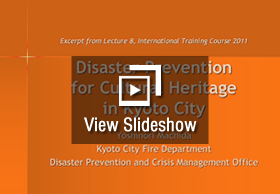

Emergency Response and Recovery of Movable Cultural Heritage, International Training Course 2011
Instructor: Aparna Tandon
Read More...
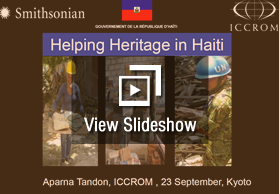
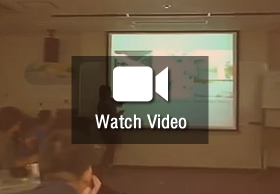
Site visits could be useful in showcasing working emergency response equipment and procedures. Specific themes could be explored in depth through site visits, such as demonstration of various facilities in place to respond to a fire or a flood in a cultural heritage site or identifying and planning evacuation routes in dense urban fabric. The site visit could also potentially link to a workshop or role-playing exercise.
Site: Ninna-ji Temple, Kyoto, R-DMUCH International Training Course, 2012
Instructor: Hikokazu Omori
Duration: 120 minutes
Read More...

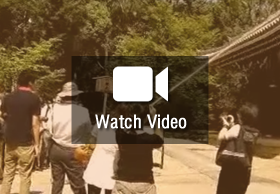
Participants could use a primary case study as the potential subject of the role-playing exercise and emergency drill/simulation exercise. Such an exercise would entail participants taking on roles of heritage managers, residents, local police and fire fighting officers etc. Based on the scenario presented to them, they may be asked to determine exact protocols and emergency procedures for a heritage site. Such an exercise could also be linked to the disaster imagination game, from Module 2, depending on the scope of the course.
Site: Kiyomizu-dera, Sanneizaka District
Workshop on Role Playing
Read More...
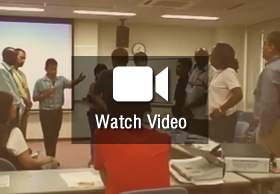
Participants may also use this stage within the course to carry out individual exercises using their selected case studies. This would help them further develop their own disaster risk management plans.
Site: Cusco, Peru, International Training Course 2010
Participants: Teresa Vilcapoma Huapaya and Olga Keiko Mendoza Shimada
Read More...
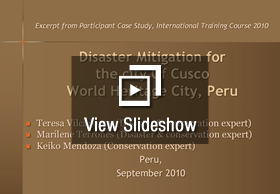


Site: Taj Mahal, India,
Participant: Janwij Sharma
Read More...
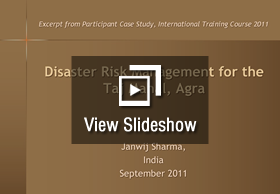
This section focuses on the various approaches and methodologies for preventing and mitigating disaster risks to cultural heritage. This generally involves one or more of the following approaches
Key aspects to be introduced and discussed
A policy of minimal intervention should be retained as much as possible; the values, authenticity and integrity of the cultural heritage should be considered while deciding appropriate mitigation measures. Reviews should be done periodically to the disaster risk management strategy to prevent any unintended impact of risk-reduction activities.
Core Lectures
The instructor can illustrate the various aspects of emergency preparedness and response through established planning, protocols and procedures by means of examples and case studies. Checklists of protocols and procedures applicable in different emergency situations can be circulated. The basic skills needed in order to identify potential evacuation routes, design emergency signage, install equipment for monitoring an effective and timely response and build emergency response teams for a heritage site may be identified in the lecture.
Thematic Lectures with Secondary Case Studies
Thematic lectures may be used to illustrate specific aspects of emergency preparedness.
Secondary case studies may be integrated within the lecture presentations to highlights various aspects of emergency preparedness and response. Examples of how site managers have responded to disasters could be used to illuminate best practices as well as highlight possible gaps in management.
Site Visits
Site visits could be useful in showcasing working emergency response equipment and procedures. Specific themes could be explored in depth through site visits, such as demonstration of various facilities in place to respond to a fire or a flood in a cultural heritage site or identifying and planning evacuation routes in dense urban fabric. The site visit could also potentially link to a workshop or role-playing exercise.
Primary Case Study -Workshop
Participants could use a primary case study as the potential subject of the role-playing exercise and emergency drill/simulation exercise. Such an exercise would entail participants taking on roles of heritage managers, residents, local police and fire fighting officers etc. Based on the scenario presented to them, they may be asked to determine exact protocols and emergency procedures for a heritage site. Such an exercise could also be linked to the disaster imagination game, from Module 2, depending on the scope of the course.
Participant's Case Study Project
Participants may also use this stage within the course to carry out individual exercises using their selected case studies. This would help them further develop their own disaster risk management plans.
Disaster Prevention for Cultural Heritage in Kyoto City, Lecture 8, International Training Course 2011
Instructor: Yoshinori Machida | Duration: 60 minutes
This lecture links mitigation (previous module) with emergency response (current module) as well as the long term recovery process (next module).
The instructorintroduced the history and background of Kyoto city as well as described the various disasters that have taken place in its long history. He also emphasisedearthquakes as a potential disaster, using the example of the Hanshin Awaji Earthquake. The session introduced the Kyoto City Disaster Prevention Plan, which is envisioned to be implemented in cooperation with private citizens, communities and public offices.It also illustrated disaster prevention planning at neighborhood level.
The following disaster prevention measures were discussed in detail:
Broadly, the countermeasures in the event of a disaster for the protection of cultural assets were described for visitors as well as for movable assets.
Additionally measures for long-term response and recovery were described:
The recent cooperation agreement between owners of cultural assets and their neighbors (2000~) was discussed. This agreement was drawn up between owners of cultural assets and their neighbours to enable rapid and efficient response to a fire in cooperation with each other.




Emergency Response and Recovery of Movable Cultural Heritage, International Training Course 2011
Instructor: Aparna Tandon | Duration: 60-80 minutes
The session was aimed at promoting better understanding of the sources of risk to a broad range of movable cultural materials during emergency and early recovery situations and the specific considerations that have to be taken into account before mounting response and recovery operations for safeguarding cultural heritage collections. Participants were introduced to various processes identifying ‘agents of deterioration’ or sources of risk to cultural heritage objects and collections immediately following an emergency situation. The second half of the session addressed specific aspects of recovering cultural heritage collections in the aftermath of a disaster. It includeda discussion of the documentation of cultural artifacts, levels of protection, prioritisationof artifacts for maximum protection, handling procedures and salvage considerations, off-site temporary storages, emergency supplies, specialisedhelp, communications and rapid response teams.
The secondary case example of Haiti was used to illustrate the process. Six months after the earthquake in Haiti, much of the movable cultural heritage in Haiti was in danger of being damaged irreversibly or lost altogether.
The first response of the International Centre for the Studyof the Preservation and Restoration of Cultural Property (ICCROM) to the cultural emergency in Haiti was to strengthen the capacity of the staff of Haiti’s cultural institutions for creating saferstorage conditions for the endangered collections. Carried out in partnership with theMinistry of Culture of Haiti and the Smithsonian Institution (USA) within the framework of its Cultural Recovery Project, the three-week courseon First Aid to Cultural Heritage in Haiti was held in Port au-Prince.
In the absence of any other form of shelter, putting works of art in a container, on a temporary basis, seemed to be the most appropriate solution. However, the metal containers were not sealed properly, which allowed moisture to seep in. In addition, theywere exposed to extreme weather conditions.
Within six months several works of art inside the containers were infected by mould. Isolating the contaminated works of art and creating another temporary but safe storage spacewas the top priority. The board of trustees of the Centre d’Art, however, expressed serious concerns over the security and the safety of the collection. Following several consultations and after having assessed possible threats and potential benefits, the trusteesallowed the containers to be relocated andunloaded. At the time of the training, four of the fifteen participating institutions had parts of their collections buried under the rubble. The lack of building plans and maps foridentifying the possible locations of buried artifacts added to the complexity of the task. The participants were organisedinto an emergency team and were given specific tasks, ranging from documentation to first-aid treatments and the packing of works of art.
As a direct result of the training, over 1,500 works of art of the Centre d’Art were documented and saved from further damage. In addition, fourteen institutions were able to develop concrete action plans for securing their respective collections. Based on the strategies discussed during the course, they were encouraged to think of at least ten actions that they would implement without additional resources. The most significant outcome, however, isthe formation of a self-reliant and strong team of26 professionals who are workingtogether to recover Haiti’s cultural heritage.





Site:Ninna-ji Temple, Kyoto, R-DMUCH International Training Course, 2012
Instructor: Hikokazu Omori | Duration: 120 minutes
The Ninna-ji Temple in Kyoto was completed by the Emperor Uda in 888 and consecrated as an imperial temple. In the modern age, several temple buildings were either partially or totally dismantled and repaired; included among these were the Kondo(1914), the Niomon (1938), and the Mieido (1951). The temple is now inscribed as a UNESCO World Heritage Site.
The Kondo (G1), is a large scale structure 7 bays across the front by 5 bays on the sides. It has shitomido (tophinged, swinging windows) on four sides and hiwada (eaves constructed with a triple-layer rafter system). Although it has undergone reconstruction, the Kondo is highly valued as historically important due to the fact that it retains the imperial palace style of the Momoyama Period.


Site: Kiyomizu-dera, Sanneizaka District
Workshop on Role Playing
Each participant was randomly assigned pre-determined roles to perform for the purposes of the workshop. For the exercise in the International Training Course 2011, the following roles were assigned to participants
The participants were introduced to an emergency scenario in a heritage site described as follows:
There is a fire in a row of wooden houses in Sanneizaka Historic Preservation District near Kiyomizu-dera. Fire started from a cooking pan in the kitchen of a shop. It spread to cloth materials like curtains and then to timber elements. The whole shop was on fire and it started spreading to adjacent houses. Nearby Kiyomizu temple is also under grave threat of catching fire if immediate action is not taken.There is limited access to the fire affected area due to the close proximity of houses and narrow access roads. The incident happened during the daytime, when all young people had gone to work and school, and only elderly people were at place. Some domestic and foreign tourists were on the road.
The fire detecting system in the house where the house started was not maintained. Fire extinguishers could not be used immediately. Old people and the foreign tourists could not read the emergency signage.
The participants undertook a role-playing exercise through which they tried to respond to the given scenario, by assuming their respective roles during the emergency situation. This was followed by a de-briefing of the exercise to formulate response plans by deciding upon specific roles and actions by various stakeholders, their sequence, time period and chain of command.

| STEP 1 | STEP 2 | ||||
| S.No. | Activities | Time Period | Whose Resposibility? | Coordination System | Priority/Sequence |
Site: Cusco, Peru, International Training Course 2010
Participants: Teresa Vilcapoma Huapaya and Olga Keiko Mendoza Shimada
The City of Cusco was inscribed on the World Heritage List in 1983. It has suffered extensive damage previously in 2007 as a result of an earthquake.
The disaster scenario created by the participants was an earthquake of magnitude 8 which would have a severe impact on the physical fabric of the city with the loss of life and cultural properties. The earthquake would also set off landslides leading to further damage. The objective of the Disaster Risk Management Plan would be to contribute to reducing the effects of the disaster. Mitigation and preventative actions would need to be carried out.
The mitigation measures would include appropriate government policies, land use, building guidelines, evacuation plans, drills, maintenance and monitoring procedures and technical measures for the strengthening of monuments. The Emergency Team would be comprised of the three main stakeholders (the Municipality of Cusco, the National Institute of Culture and the National Institute of Civil Defence) as well as the fire brigade, police force, the community and volunteers. In the Emergency Preparedness and Response Plan the evacuation routes and safe areas were identified. The rescue routes were identified along with the locations of fire hydrants.
Study Project, International Training Course
Site: Taj Mahal, India | Participant: Janwij Sharma
The Taj Mahal, Agra is a UNESCO World Heritage Site in a complex urban environment, surrounded by high-density settlement. Though the likelihood of a natural disaster such as earthquake or flood is low, the vulnerability of the site is very high due to the high amount of visitor traffic. The participant identified crowd management as one of the most critical issues which needed to be addressed as part of the response and recovery procedures.
Crowd Management – Response and Recovery
A key vulnerability in Taj Mahal is the possible scenario of mobbing and difficulty in managing crowds. Given, the single entry and exit point to the site, sudden evacuation becomes a major challenge from within the mausoleum and at the entry points. One of the first remedial measures for these issues is to limit the entry of people into the main mausoleum and deploy expert personnel at entry and exit. Appropriate signage should be provided along the circulation routes. In the long term, strategies for circulation and movement and personnel should be implemented for crowd management.
The participant then went on to mark out evacuation routes and relief spaces, based on his experience and knowledge of the site and the series of disaster risk management workshops held during the International Training Course organised by Rits DMUCH 2011.